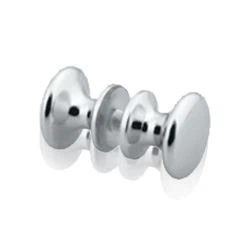Hey there! As a supplier of Quick Release Hinges, I often get asked about how to install these nifty little things on a wooden door. Well, you're in luck because I'm gonna walk you through the whole process step by step.
First off, let's talk about why you might want to use a quick release hinge. These hinges are super handy if you need to remove the door frequently. Maybe you're doing some painting, or you need to clean the door thoroughly. With a quick release hinge, you can take the door off in a jiffy and put it back just as easily.
What You'll Need
Before we start the installation, let's gather all the tools and materials you'll need. You'll need a tape measure, a pencil, a drill with the appropriate drill bits, a screwdriver, and of course, the quick release hinges. Make sure you've got the right size hinges for your door. As a supplier, I can tell you that getting the right size is crucial for a proper fit.
Step 1: Measure and Mark
The first step is to measure and mark the position where you'll install the hinges. Start by measuring the height of the door. Most wooden doors will need at least two hinges, one near the top and one near the bottom. For a standard-sized door, you'll want to place the top hinge about 7 inches from the top of the door and the bottom hinge about 11 inches from the bottom.
Use your tape measure to get these measurements and mark the spots on the door with a pencil. Then, hold the hinge up to the marked spot and trace around it with the pencil. Do this for both the door and the door frame. Make sure the marks on the door and the frame line up perfectly.


Step 2: Drill the Pilot Holes
Once you've marked the hinge positions, it's time to drill the pilot holes. Pilot holes are small holes that you drill before inserting the screws. They help prevent the wood from splitting and make it easier to insert the screws.
Use a drill bit that's slightly smaller than the screws you'll be using. Carefully drill the pilot holes at the marked spots on both the door and the frame. Make sure the holes are straight and go in at the right depth.
Step 3: Attach the Hinges
Now it's time to attach the hinges. Take one of the hinges and align it with the pilot holes on the door. Insert the screws into the holes and use a screwdriver to tighten them. Make sure the hinge is firmly attached to the door. Do the same for the other hinge on the door.
Next, attach the corresponding hinges to the door frame. Align the hinges with the pilot holes on the frame and insert the screws. Tighten the screws until the hinges are securely attached to the frame.
Step 4: Test the Door
Once you've attached all the hinges, it's time to test the door. Carefully lift the door and place it in the frame, aligning the hinges on the door with the hinges on the frame. Lower the door onto the frame and make sure it hangs properly.
Open and close the door a few times to make sure it swings smoothly. If the door doesn't open or close easily, you may need to adjust the hinges. You can do this by loosening the screws slightly and moving the hinge until the door swings freely.
Step 5: Adjust the Quick Release Mechanism
Now that the door is hanging properly, it's time to adjust the quick release mechanism. Most quick release hinges have a simple mechanism that allows you to remove the door quickly. Follow the manufacturer's instructions to adjust the mechanism so that it works smoothly.
Test the quick release mechanism by removing and reattaching the door a few times. Make sure it's easy to use and that the door stays securely in place when it's attached.
Other Types of Hinges
As a quick release hinge supplier, I also offer a variety of other types of hinges. For example, if you're looking for a hinge that doesn't require mortising, check out our Non Mortice Stainless Steel Hinge. These hinges are easy to install and are made of durable stainless steel.
If you're working on a boat or a project that requires a specialized hinge, we also have Boat Hatch Swaged Hinge. These hinges are designed to withstand the harsh marine environment and are perfect for boat hatches.
And if you need a hinge that provides some resistance when opening and closing, our Stainless Steel Friction Hinge is a great option. These hinges are commonly used in applications where you want the door or lid to stay in a certain position.
Conclusion
Installing a quick release hinge on a wooden door is a relatively simple process that you can do yourself with the right tools and a little bit of patience. By following these steps, you'll have your door installed and working properly in no time.
If you're interested in purchasing quick release hinges or any of our other hinge products, feel free to reach out for a purchase consultation. We're here to help you find the right hinges for your project.
References
- "Woodworking Basics: Hinge Installation" - Woodworking Magazine
- "Door Hardware Installation Guide" - Home Improvement Handbook



